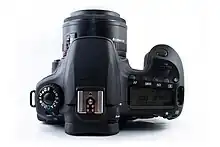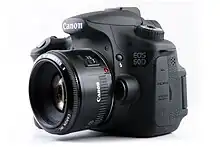 | |
| Overview | |
|---|---|
| Type | Digital single-lens reflex camera |
| Intro price | US$1099.00[1] |
| Lens | |
| Lens | Interchangeable (EF / EF-S) |
| Sensor/medium | |
| Sensor type | CMOS |
| Sensor size | 22.3 × 14.9 mm (APS-C format) |
| Maximum resolution | 5184 × 3456 pixels (4.3 μm pixel size)[2] (18.1 effective megapixels) |
| Film speed | 100 – 6400 (expandable to H: 12800) |
| Storage media | SD/SDHC/SDXC (Does not exploit UHS-I bus) |
| Focusing | |
| Focus modes | One-Shot, AI Focus, AI Servo, Live View (FlexiZone - Multi, FlexiZone - Single, Face detection, AF Quick) |
| Focus areas | 9 cross-type AF points |
| Exposure/metering | |
| Exposure modes | Full Auto, Flash Off, Creative Auto, Portrait, Landscape, Close-up, Sports, Night Portrait, Program AE, Shutter priority AE, Aperture priority AE, Manual exposure, Bulb exposure, Custom, Movie |
| Exposure metering | Full aperture TTL, 63 zones iFCL SPC |
| Metering modes | Evaluative, Partial, Spot, Centre-weighted Average |
| Flash | |
| Flash | E-TTL II auto-pop-up built-in / External |
| Flash bracketing | N/A |
| Shutter | |
| Shutter | Electronic focal-plane |
| Shutter speed range | 1/8000 sec. – 30 sec. and Bulb; X-sync at 1/250 sec. |
| Continuous shooting | Up to 5.3 fps |
| Viewfinder | |
| Viewfinder | Eye-level pentaprism with 96% coverage and 0.95x magnification / LCD (Live View) |
| Image processing | |
| Image processor | DIGIC 4 |
| White balance | Auto, Daylight, Shade, Cloudy, Tungsten, White Fluorescent, Flash, Custom, Kelvin (2500 - 10000K in 100K steps) |
| General | |
| LCD screen | 3.0" (7.7 cm) Clear View II colour LCD screen with 1,040,000 dots resolution |
| Battery | Li-Ion LP-E6 rechargeable (1800 mAh) |
| Optional battery packs | BG-E9 grip allows the use of 6 AA cells, one LP-E6 battery or two LP-E6 batteries |
| Dimensions | 144.5 mm × 105.8 mm × 78.6 mm (5.69 in × 4.17 in × 3.09 in) |
| Weight | 755 g (26.6 oz) |
| Made in | Japan |
| Chronology | |
| Predecessor | Canon EOS 50D |
| Successor | Canon EOS 70D |
The Canon EOS 60D is an 18.1 megapixels semi-pro digital single-lens reflex camera made by Canon. It was announced on August 26, 2010, with a suggested retail price of US$1099.00.[1] As a part of the Canon EOS two-digit line, it is the successor of the EOS 50D and is the predecessor of the EOS 70D.
It is the first Canon EOS camera which has an articulating LCD screen. Apart from its screen, the main new features of the 60D in the two-digit Canon line include increased resolution and ISO range, full-HD video capabilities, and in-camera post-processing functions for the images. However, it uses the DIGIC 4 image processor.
Like the 50D, the camera has an LCD of settings on the top of the camera where the ISO, AF-Mode, Shooting mode, and metering mode can be controlled.
The 60D is offered for purchase as a body alone or in a package with an EF-S 18-200mm f/3.5-5.6 IS lens, EF-S 17–85mm f/4-5.6 IS USM lens, EF-S 18–135mm f/3.5-5.6 IS lens, EF-S 17-55mm f/2.8 IS USM lens, or an EF-S 18–55mm f/3.5–5.6 lens
Features
Compared to the EOS 50D, the following changes have been made, including:
- Resolution increase to 18.1 megapixels APS-C CMOS Sensor (50D has 15.1 megapixels).
- Maximum sensitivity increased to ISO 6400 (12800 as optional expanded setting) (50D has max 3200 ISO, with 6400 and 12800 as optional expanded settings).
- Video recording, with same controls as the 550D/Rebel T2i.
- Manual control of audio recording (same as newer firmware on 5D MkII).
- Articulating screen - 3.0 inches (76 mm) with a slightly higher resolution of 1,040,000 pixels, 288 ppi, in 3:2 ratio (50D has 4:3).[lower-alpha 1]
- The 60D screen, unlike that of the 50D, matches the aspect ratio of the sensor.
- Lower maximum burst frame rate of 5.3 fps (50D maximum is 6.3 fps).
- SD/SDHC/SDXC card slot (50D uses CompactFlash).
- Smaller and lighter polycarbonate resin with glass fibre on aluminium chassis (50D has magnesium alloy body).
- Wireless Speedlite control.
- Lack of AF micro-adjustment feature (included in 50D).
- Redesign of controls – multi-controller has been relocated to center of quick control dial; top buttons of 60D control only one setting.
- Locking mode dial.
- Electronic level that can be viewed in the viewfinder, rear LCD monitor, and top LCD panel.
- LP-E6 battery, as used in the 5D MkII and 7D.
- Lack of PC socket for flash synchronization.
- External shutter release port changed from 'Canon N3' socket to 3/32" (2.5mm) TRS pin.
- In-camera raw development and built-in creative filters and special effects.
- External 3.5mm stereo microphone jack
Digital Photography Review described the changes as representing the move from 'semi-pro'/'prosumer' to 'enthusiast'[3] due to the reduction in some features; however the pentaprism viewfinder and iconic rear control wheel remain, as does the top informational LCD. The slightly smaller body retains the grip of the two-digit Canon line.[4]
Gallery
 The articulated display
The articulated display Top view
Top view Back view
Back view 60D with mounted 50mm f/1.8 II
60D with mounted 50mm f/1.8 II
EOS 60Da

Canon announced a modified version of the EOS 60D for astrophotography on April 3, 2012, called the EOS 60Da. The 60Da is the successor to the EOS 20Da. It was expected to cost $1,499.[5] The camera has a modified infrared filter and a low-noise sensor with heightened hydrogen-alpha (H-alpha) sensitivity for improved capture of red hydrogen emission nebulae.[6] The 60Da is three times as sensitive to H-alpha light as the 60D to allow for better images of nebulae.[7]
Notes
- ↑ Canon counts the sub-pixels of each pixel, i.e. the red, green, and blue channel of each pixel, and therefore specifies the rear display to have 345,600 × 3 = 1,036,800 or ca. 1,040,000 dots.
References
- 1 2 "Canon EOS 60D First Impressions Review". DigitalCameraInfo.com. Archived from the original on January 21, 2013. Retrieved January 11, 2012.
- ↑ "EOS 60D Specifications" (PDF). August 26, 2010. Retrieved August 26, 2014.
- ↑ "Canon EOS 60D DSLR announced and previewed: Digital Photography Review". Dpreview.com. August 26, 2010. Retrieved September 12, 2010.
- ↑ Laing, Gordon (October 2010). "Canon EOS 60D design and controls". CameraLabs.com. Retrieved January 22, 2012.
- ↑ "New Canon EOS 60Da DSLR Camera For Astronomy Enthusiasts Captures The True Colors Of The Cosmos". Retrieved April 3, 2012.
- ↑ "CanonEOS 60Da astrophotography camera announced". April 3, 2012.
- ↑ Dyer, Alan (September 2012). "The 60Da: Canon's Astrophoto DSLR". Sky & Telescope. 124 (3): 38–41. ISSN 0037-6604.
External links
 Media related to Canon EOS 60D at Wikimedia Commons
Media related to Canon EOS 60D at Wikimedia Commons- Canon USA 60D Press release
- Canon 60D Review
- DPReview 60D Preview
- DPReview 60D Review
- Deciding on Buying a Canon 60D – Features Archived July 25, 2011, at the Wayback Machine
- Canon 60D Review – ZTech Archived January 9, 2014, at the Wayback Machine